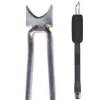Does anyone know of a good closeup video of turning decorative beads on the outer rim of a bowl and on the base of a bowl or platter.
I find that after all the work it takes me to make a nice bowl I'm afraid of turning a decorative bead because the few times I have tried it I get a dreaded spiral catch. I don't care for bead turning tools as they always seem to leave some tearout -- as expected in that they are essentially scraping tools. I know my problem is tool presentation and I would love to see a close up video. I have seen a Richard Raffin video in which he quickly makes a bead on the side of a bowl and comments that people tend to add too many beads once they see how easy it is--- but he doesn't really show how to do it. Suggestions would be much appreciated.
I find that after all the work it takes me to make a nice bowl I'm afraid of turning a decorative bead because the few times I have tried it I get a dreaded spiral catch. I don't care for bead turning tools as they always seem to leave some tearout -- as expected in that they are essentially scraping tools. I know my problem is tool presentation and I would love to see a close up video. I have seen a Richard Raffin video in which he quickly makes a bead on the side of a bowl and comments that people tend to add too many beads once they see how easy it is--- but he doesn't really show how to do it. Suggestions would be much appreciated.

